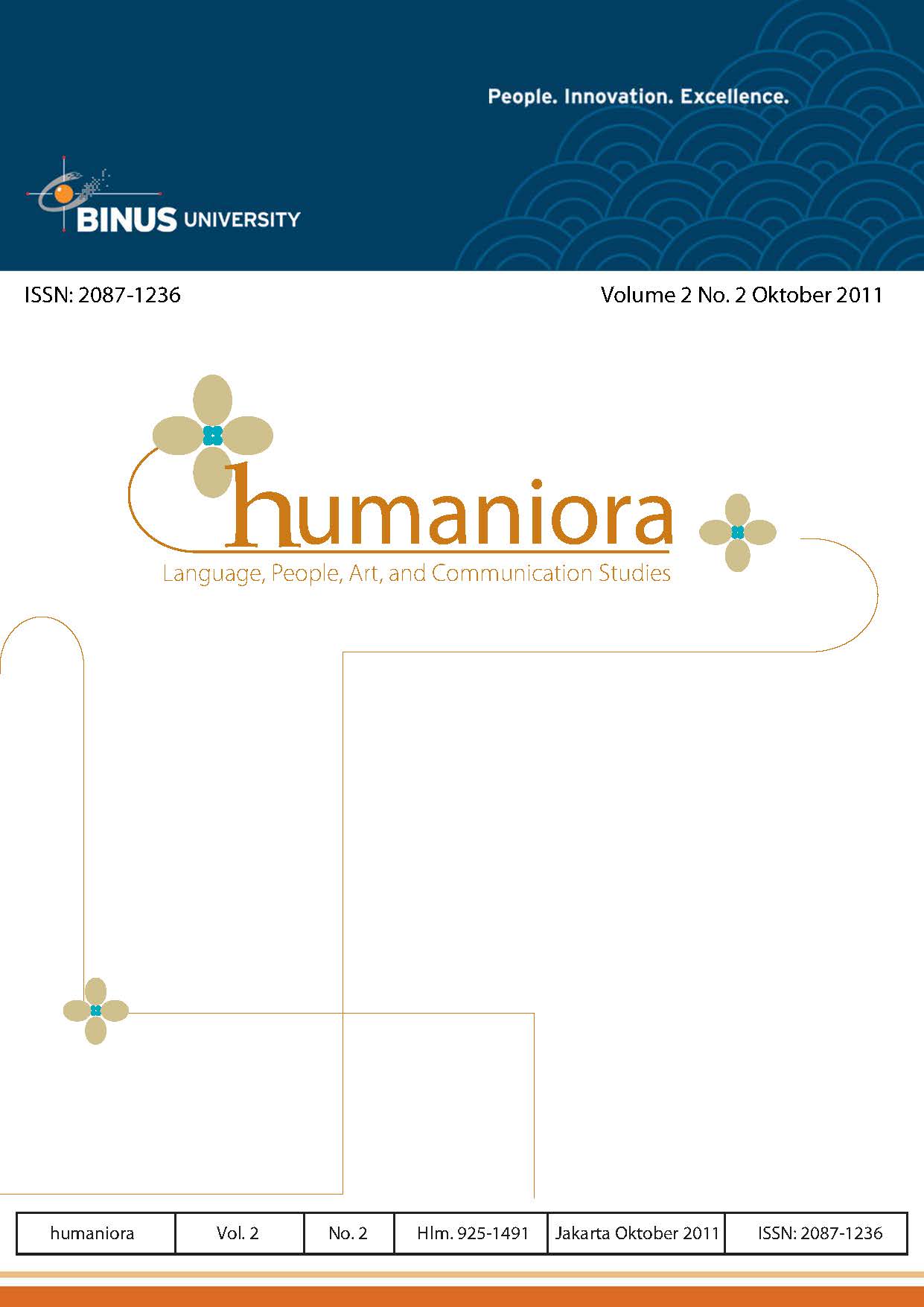Pornografi dalam Balutan Film Bertema Horor Mistik di Indonesia
DOI:
https://doi.org/10.21512/humaniora.v2i2.3209Keywords:
film, horror, mystic, pornographyAbstract
The film industry in Indonesia has been through ups and downs. As an industry, thus there are usual things the film creators done to take financial benefit from the film industry. Some researches show that messages brought by mass communication media is no more that political and economic efforts from media to get much more benefits. Therefore, it is acknowledged that Indonesian films lately put horror and mystic theme beneath in order to get closer with Indonesia culture as the consumers. However, it is issued when the mystic theme influenced along with pornography. Ethics development efforts and law enforcement must be the continuous material to discuss the problem solving.
Â
Â
References
Adorno, T. W., & Horkheimer, M. (1995). The culture industry: Enlightenment as mass deception. Dalam O. B. Barret & C. Newbold (Eds.), Approaches to media: A reader, hal. 77. London: Arnold.
Barret, O. B., & Newbold, C. (1995). Aproaches to media: A reader. London: Arnold.
Bungin, B. (2009). Sosiologi komunikasi, teori paradigma, dan diskursus teknologi komunikasi di masyarakat. Kencana.
Derry, C. (1977). Dark dreams: A psychological history of the modern horror film. Ohio: Barnes Noble.
Encyclopedia of Communication and Information. (2001). USA: Macmillan Reference.
Harris, P. R., & Moran, R. T. (2006). Memahami perbedaan-perbedaan budaya. Dalam D. Mulyana & J. Rakhmat (Eds.), Komunikasi antarbudaya: Panduan berkomunikasi dengan orang-orang berbeda budaya (hal. 62). Bandung: Remaja Rosdakarya.
Haryatmoko. (2007). Etika komunikasi, manipulasi media, kekerasan dan pornografi. Kanisius.
Heider, K. G. (1991). Indonesian cinema: National culture on screen. Honolulu: University of Hawaii Press.
Ibrahim, M. D. (1996). Citra perempuan dalam media: Eksploitasi dan sensasi sadistik. Dalam I. S. Ibrahim (Ed.), Lifestyle ecstasy: Kebudayaan pop dalam masyarakat komoditas Indonesia. Yogyakarta: Jalasutra.
Koentjaraningrat. (2009). Pengantar ilmu antropologi. Jakarta: Rineka Cipta.
Milner, A., & Browit, J. (2002). Contemporary cultural theory: An introduction (3rd ed.). London: Routledge.
Nighthale, V. (1996). Studying audience: The sock of the real. London: Routledge.
Republik Indonesia. (2009). Undang-Undang Nomor 33 tahun 2009 tentang Perfilman. Jakarta.
¬¬¬Republik Indonesia. (1994). Peraturan Pemerintah Republik Indonesia Nomor 7 Tahun 1994 tentang Lembaga Sensor Film. Jakarta: Lembaran negara Republik Indonesia Tahun 1994 Nomor 12.
Pattisina, E. C. (2007, Maret). Selamat datang di republik hantu. KOMPAS, 25 Maret 2007.
Porter, R. E., & Samovar, L. A. (2006). Suatu pendekatan terhadap komunikasi antar budaya. Dalam D. Mulyana & J. Rakhmat (Eds.), Komunikasi antarbudaya: Panduan berkomunikasi dengan orang-orang berbeda budaya (hal. 18). Bandung: Remaja Rosdakarya.
Sabidy, D. A. (2005). Xxxxxxx. Jurnal Thesis 2004: Jurnal Penelitian Ilmu Komunikasi, Volume IV/No. 1 Januari-April 2005, Hal. 55.
Shoemaker, P. J., & Reese, S. D. (1991). Mediating the message: Theories of influences on mass media content. New York: Longman.
Sobur, A. (2003). Semiotika komunikasi. Bandung: Remaja Rosdakarya.
Straubhaar, J., La Rose, R., & Davenport, L. (2004). Media now, understanding media, culture, and technology (4th ed.). USA: Wadsworth/Thomson Learning.
Downloads
Published
How to Cite
Issue
Section
License
Authors who publish with this journal agree to the following terms:
a. Authors retain copyright and grant the journal right of first publication with the work simultaneously licensed under a Creative Commons Attribution License - Share Alike that allows others to share the work with an acknowledgment of the work's authorship and initial publication in this journal.
b. Authors are able to enter into separate, additional contractual arrangements for the non-exclusive distribution of the journal's published version of the work (e.g., post it to an institutional repository or publish it in a book), with an acknowledgment of its initial publication in this journal.
c. Authors are permitted and encouraged to post their work online (e.g., in institutional repositories or on their website) prior to and during the submission process, as it can lead to productive exchanges, as well as earlier and greater citation of published work.
USER RIGHTS
All articles published Open Access will be immediately and permanently free for everyone to read and download. We are continuously working with our author communities to select the best choice of license options, currently being defined for this journal as follows: Creative Commons Attribution-Share Alike (CC BY-SA)




















